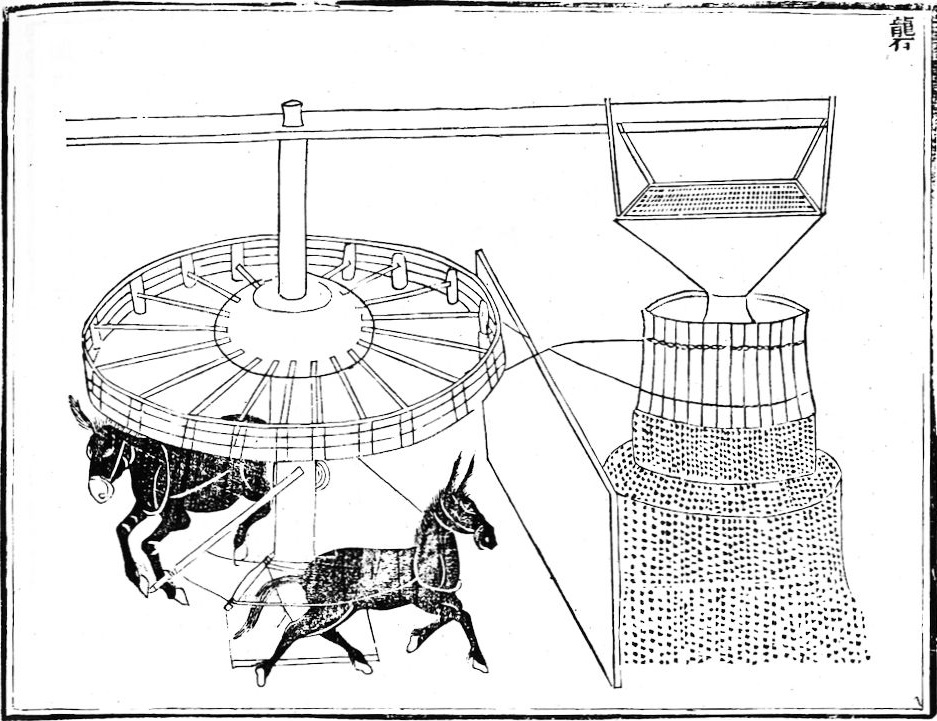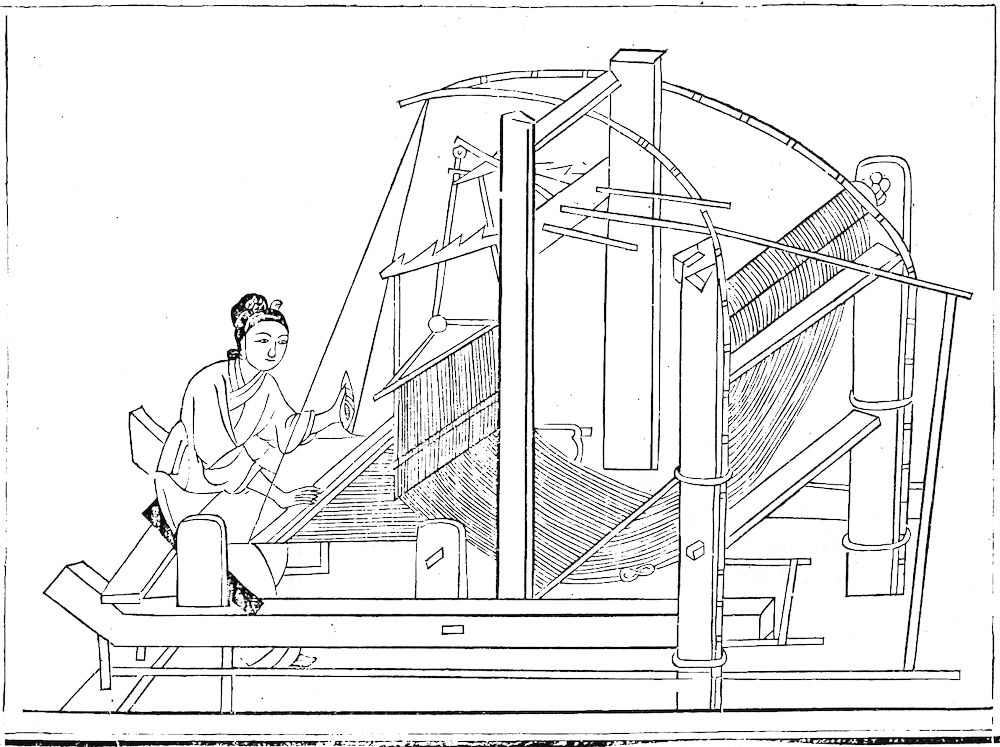There are three texts of the title Nongshu "Book on agriculture", one written by the Northern-Song-period 北宋 (960-1126) scholar Chen Fu 陳旉 (1076-1156; also called Chen Fu Nongshu 陳旉農書), one by the Yuan-period 元 (1279-1368) master Wang Zhen 王禎 (1271-1333), and one written by a Ming-period 明 (1368-1644) scholar called Master Shi, the Shenshi nongshu 沈氏農書. Further books with the same title were written by Liu Qingzhi 劉清之 (1133-1189), Chen Jun 陳峻 (b. 1431) and Fan Dacheng 潘大成.
Wang Zhen 王禎, courtesy name Boshan 伯善, hailed from Dongping 東平 (today in Shandong) and was district magistrate in Jingde 旌德 (modern Jingde, Anhui) and later in Yongfeng 永豐 (modern Yongfeng, Jiangxi). In this position he actively promoted the amelioration of agricultural tools, raising methods for trees, hemp and cotton, and began writing the 20-juan-long book Nongshu. The book is enriched with an appendix that includes a text on moveable letter printing (Zao huozi yinshu fa 造活字印書法), a technique that was relatively new at that time. This text is the earliest explanation of this topic.
Wang Zheng's Nongshu was finished in 1313. It is composed of three parts, firstly a general overview of all topics and issues of agriculture and sericulture (Nongsang zongjue 農桑總訣), in 6 collections (ji 集). In this part the author provides information about the importance of weather, the soil, techniques of ploughing, weeding and planting, fertilizing, irrigation, harvesting, as well as the breeding of cattle and silkworms. It consists of quotations from older books as well as by texts compiled by Wang Zhen himself, based on his experience. Wang Zhen describes different types of rice (long-grained non glutinous rice xian 籼 or jing 粳, and glutinous rice nuo 糯) and their cultivation, and explains that vegetables (shucai 蔬菜) were better planted directly side by side in large fields (muzhong 睦種) and melons (gua 瓜) in compartments (quzhong 區種). Plants infested with parasites could be cured by smashed Sophora root (kushen gen 苦參根) and lime (shihui 石灰). Wang Zhen also explains six methods of propping (jiajie 嫁接).
 |
Reproduction by the Guangya Shuju 廣雅書局 of a the moveable-type print of the Hall of Military Glory (Wuyingdian juzhen ben 武英殿聚珍本) |
Secondly, an explanation of all agricultural products (Baigupu 百穀譜) in 11 collections. The author informs about the types of crops, their names, designations and origins, and methods of cultivation in different regions. Wang Zhen describes various kinds of grain like wet rice, dry rice or wheat, and a large number of vegetables, from planting, rearing, harvesting to storing and processing. He also mentions crops in Southeast Asia and other foreign countries like rice (dao 稻), fragrant rice (xiao xiangdao 小香稻), water melons (xigua 西瓜), spinach (bocai 菠菜) and hemp (zhuma 苧麻) that came into use in China during the Yuan period.
Thirdly, descriptions (in poems and rhapsodies) of a wide range of various tools and implements used in these two branches of economy, enriched by 273 of drawings (Nongqi tupu 農器圖譜) in 20 collections. These illustrations are accompanied by texts describing the use, origin and production of various tools in agriculture. For some, poems are quoted related to the objects. Not all implements were still in use during the Yuan period, but the Nongshu is a source in which information of ancient and obsolete tools is preserved.
The illustrations make Wang Zhen's Nongshu a real treasure of agriculture in ancient China. His book unite information on agricultural techniques in both northern and southern China, which is not seen in older tests that mostly concentrate on farming in the Yellow River plain in northern China. The Nongshu is also the first book that methodically describes all methods of the use of soil, like polders (weitian 圩田), paddy fields (weitian 圍田), embankment fields (guitian 櫃田), floating farmland (jiatian 架田), terrace fields (titian 梯田), muddy fields (tutian 塗田), and the like, with different shapes of field compartment and diverse irrigation methods.
 |
The Nongshu is enriched with an appendix of "Miscellaneous records" (Zalu 雜錄) that includes a text on moveable letter printing (Zao huozi yinshu fa 造活字印書法), a technique that was relatively new at that time, and a text on preservation methods for buildings (Fazhi changsheng wu 法制長生屋), among these even the creation of fire-proofness. This text is the earliest explanation of this topic.
In the first print of the book that was published in 1204 it is said that the text consisted of three different writings, namely the three parts of which the transmitted version consists. It is therefore quite sure that Wang Zhen never planned to publish his writings as a coherent book.
The compilers of the imperial series Siku quanshu 四庫全書 praised the high quality of Wang Zhen's Nongshu in contrast to the much simpler books Nongsang jiyao 農桑輯要 and Nongsang yishi cuoyao 農桑衣食撮要. The Nongshu was included in the huge Ming-period encyclopaedia Yongle dadian 永樂大典, with a size of 8 juan. This version was used during the compilation of the Siku quanshu, but was revised and polished to a 22-juan-long version. It is also included in a series of high-quality palace prints, the Wuyingdian juzhenban shu 武英殿聚珍版書. In other editions the text is arranged in 37 juan, with one juan missing. In 1956 the Zhonghua Shuju Press 中華書局 published a joint version of three books with the title Nongshu (Shenshi nongshu 沈氏農書, Chen Fu Nongshu and Wang Zhen Nongshu 王禎農書), and a separate edition of Wang Zhen's Nongshu. In 1963 the Nongye Press 農業出版社 also published this book, as well as a new edition in 1981 that includes Wang Youhu's 王毓瑚 commentary. Wang Zhen's Nongshu is also included in the series Wanyou wenku 萬有文庫.
| 1-6. | 農桑通訣 | General notes on agriculture and silk production |
| 7-26. 農器圖譜 Pictures and notes on agricultural instruments (etc.) | ||
|---|---|---|
| 7. | 田制門 | Field systems |
| 8. | 耒耜門 | Ploughs |
| 9. | 钁臿門 | Mattocks and hoes; separating grain from husk |
| 10. | 錢鎛門 | Spades |
| 11. | 銍艾門 | Sickles |
| 12. | 杷朳門 | Harrows and rakes |
| 13. | 蓑笠門 | Rustic cloaks and hats |
| 14. | 蓧簣門 | Weeders and baskets |
| 15. | 杵白門 | Mortars and pestles |
| 16. | 倉廩門 | Granaries and barns |
| 17. | 鼎釜門 | Kettles |
| 18. | 舟車門 | Boats and vehicles |
| 19. | 灌漑門 | Canals |
| 20. | 利用門 | Profitability |
| 21. | 麰麥門 | Grains |
| 22. | 蠶繅門 | Silkworm breeding and reeling |
| 23. | 蠶桑門 | Mulberry cultivation |
| 24. | 織絍門 | Weaving |
| 25. | 纊絮門 | Cotton cultivation and processing |
| 26. | 麻紵, 雜錄 | Hemps; Miscellaneous |
| 27-36. 穀譜 Notes on useful plants | ||
| 27-28. | 穀屬 | Grain-like crops |
| 29. | 蓏屬 | Melon-like crops |
| 30-31. | 蔬屬 | Vegetables |
| 32-34. | 果屬 | Fruits |
| 35. | 竹木 | Bamboos and trees |
| 36. | 雜類 | Miscellaneous plants |